QUESTIONS
-
- Define density and state its SI unit (2mks)
- The mass of an empty density bottle is 20g. Its mass when filled with water is 40g and 50g when filled with liquid x. Calculate the density of liquid x if the density of water is 1000 kg/m3. (3mks)
- State and explain two factors affecting surface tension. (2mks)
- Give at three differences between mass and weight. (3mks)
- The U-tube shown below is filled with water, mercury and another liquid.
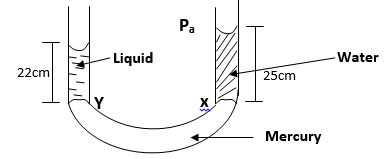
Given that density of water is 1000kg/m3 and gravity is 10N/kg.
Calculate;- Pressure at x. (2mks)
- Density of liquid in kg/m3. (2mks)
-
- State the kinetic theory of matter. (2mks)
- In term of intermolecular space and intermolecular force, differentiate between solids, liquids and gases. (2mks)
-
- Explain three effects of anomalous expansion of water. (3mks)
- Convert the following temperatures to Kelvin.
- -129ºC. (1mk)
- 0ºC. (1mk)
- State four factors affecting thermal conductivity. (4mks)
-
- By use of diagrams explain the three types of beams. (3mks)
- A pinhole camera of length 15cm forms an image 3cm high of a man standing 9m in front of the camera. What is the height of the man? (2mks)
- State two application of electrostatics. (2mks)
- Explain the dangers of electrostatics. (3mks)
- If the diameter of an oil drop is 0.5mm and it spreads on the surface of water to form an oil patch of diameter 0.2m. Estimate the length of the oil molecule and express your answer in metres. (4mks)
-
- Using a drawing and a brief explanation, show the three states of equilibrium. (6mks)
- Explain the two factors affecting stability. (2mks)
-
- A convex mirror of focal length 9cm produces an image on its axis 6cm from the mirror. Determine the position of the object. (3mks)
- State two uses of convex mirrors. (2mks)
-
- State the hooks’ law. (1mk)
- A metal cube suspended freely from one end of a spring causing it to stretch by 5.0cm. A 500g mass suspended from same spring stretches it by 2.0cm. If the elastic limit is not exceeded find;
- The weight of metal cube. (2mks)
- By what length will the spring stretch if a mass of 1.5kg is attached to its end. (2mks)
-
- State the principle of moments. (2mks)
- A meter rule is pivoted at its centre, A glass block is hung from one end and the rule is balanced horizontally by hanging masses of 100g and 50g at 60cm and 80cm marks respectively. Calculate the mass of the glass block. (3mks)
- Two people stand facing each other 200m apart on one side of a high wall and at the same perpendicular distance from it. When one fires a pistol, the other hears a report 0.6sec after the flash and a second sound 0.25sec later. Calculate;
- The velocity of sound in air. (1mk)
- The perpendicular distance of the people from the wall. (3mks)
-
- A lawn sprinkler has 40 holes, each of cross-section area of 200cm. it is connected to a hose-pipe of cross section area of 1.6cm2. If the speed of water in the hose-pipe is 1.2m/s, calculate;
- Flow rate of hose-pipe. (2mks)
- Speed at which water emerges from the holes. (2mks)
- Define the following terms as used in fluid flow.
- Volume flux. (2mks)
- Mass flux. (2mks)
- A lawn sprinkler has 40 holes, each of cross-section area of 200cm. it is connected to a hose-pipe of cross section area of 1.6cm2. If the speed of water in the hose-pipe is 1.2m/s, calculate;
- A water wave travels 12m in 4 seconds. If the frequency of the wave is 2Hz. Calculate;
- The speed of the wave. (2mks)
- The wavelength of the wave. (2mks)
MARKING SCHEME
-
- Define density and state its SI unit (2mks)
- Density is mass per unit volume.
- SI unit kg/m3
- The mass of an empty density bottle is 20g. Its mass when filled with water is 40g and 50g when filled with liquid x. Calculate the density of liquid x if the density of water is 1000 kg/m3. (3mks)
- Mass of water = 40 – 20
= 20g = 0.02kg
Density of water = 1000kg/m3
Volume of water = (0.02)/1000
= 0.00002m3 = volume of bottle
Mass of liquid = 50 – 20
= 30g = 0.03kg
Volume of liquid = volume of bottle
0.00002m3
Therefore density of liquid = (0.03)/(0.00002)
= 1500kg/m3
- Mass of water = 40 – 20
- Define density and state its SI unit (2mks)
- State and explain two factors affecting surface tension. (2mks)
- Impurities – presence of impurities lowers the surface tension.
- Temperature – Rise in temperature lowers surface tension.
- Give at least three differences between mass and weight. (3mks)
Mass Weight Measure of quantity of matter
Measured in Kg
Is a scaler quantity
Does not change with respect to places.
Measure of pull of gravity
Measured in Newtons
Is a vector quantity
Changes with respect to places.
- The U-tube shown below is filled with water, mercury and another liquid.

Given that density of water is 1000kg/m3 and gravity is 10N/kg.
Calculate;- Pressure at x. (2mks)
- P = φ×g×h
1×10×25
P = 250g/cm3
- P = φ×g×h
- Density of liquid in kg/m3. (2mks)
- Px = Py
φ×g×h=φ×g×h
φ×10×22=250
φ=250/220=1.1364g/cm3
=1136.4kg/cm3
- Px = Py
- Pressure at x. (2mks)
-
- State the kinetic theory of matter. (2mks)
- This is the constant random motion of particles in solids, liquids and gases.
- In term of intermolecular space and intermolecular force, differentiate between solids, liquids and gases. (2mks)
Solids Weight Gases Closely packed together
Have strong intermolecular forceFairly packed together
Force not as strong as in solids.Further apart from each other
Have weak intermolecular force
- State the kinetic theory of matter. (2mks)
-
- Explain at least three effects of anomalous expansion of water. (3mks)
- Freezing of lakes and ponds
- Formation of icebergs.
- Weathering of rocks.
- Bursting of waterpipes.
- Convert the following temperatures to Kelvin.
- -129ºC. (1mk)
-129 + 273 = 144K - 0ºC. (1mk)
0 + 273 = 273K
- -129ºC. (1mk)
- State the factors affecting thermal conductivity. (4mks)
- Temperature difference between the ends of the conductor
- The length of the conductor
- The cross-section area of the conductor.
- The nature of the material.
- Explain at least three effects of anomalous expansion of water. (3mks)
-
- By use of diagrams explain the three types of beams. (3mks)
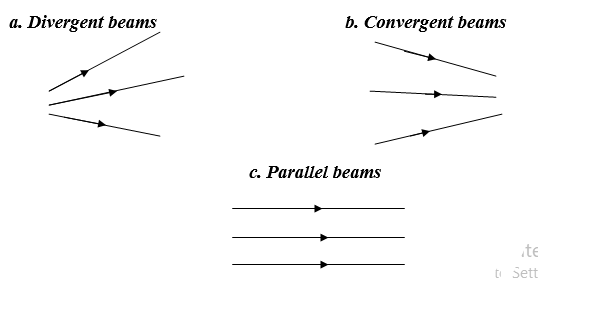
- A pinhole camera of length 15cm forms an image 3cm high of a man standing 9m in front of the camera. What is the height of the man? (2mks)
- Mag = (height of image h1)/(height of object h0 )=v/u
(0.03)/h0 =(0.15)/9
(0.03×9)/(0.15)=h0
= 1.8m.
- Mag = (height of image h1)/(height of object h0 )=v/u
- State two application of electrostatics. (2mks)
- Electrostatic precipitation
- spray painting
- photocopier.
- Explain the dangers of electrostatics. (3mks)
- Sparks and fires
- Electric shock
- Lightning.
- By use of diagrams explain the three types of beams. (3mks)
- If the diameter of an oil drop is 0.5mm and it spreads on the surface of water to form an oil patch of diameter 0.2m. Estimate the length of the oil molecule and express your answer in metres. (4mks)
- V of drop = 4/3 πr3
4⁄3×(0.5)/1000
=0.0005
4⁄3 π(0.0005)/2)3
V=6.55×10-11m
V of sphere = V of patch
6.55 ×10-11 m=22/7×0.12×h
(6.55×10-11)/(22⁄7×0.12)=h
L=2.083×10-9) m
- V of drop = 4/3 πr3
-
- Using a drawing and a brief explanation, show the three states of equilibrium. (6mks)
- Stable equilibrium – The vertical line through the centre of gravity still falls inside the base after slight displacement.
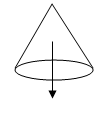
- Unstable – the vertical line through the centre falls outside the base after displacement.
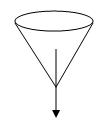
- Neutral – The vertical line through the base does not change after displacement.

- Stable equilibrium – The vertical line through the centre of gravity still falls inside the base after slight displacement.
- Explain the two factors affecting stability. (2mks)
- The area of the base.
- If base area is large, a line drawn through the centre of gravity to base remains within the base.
- Position of centre of gravity for a body to be stable the position should be as low as possible.
- Using a drawing and a brief explanation, show the three states of equilibrium. (6mks)
-
- A convex mirror of focal length 9cm produces an image on its axis 6cm from the mirror. Determine the position of the object. (3mks)
- f = -9
v = -6
using 1⁄v+1⁄u=1⁄f
1⁄(-6)+1⁄u=1⁄(-9)
(-1)⁄6+1⁄u=1⁄9
1⁄u+1⁄6-1⁄9=1⁄18
u = 18cm
- f = -9
- State two uses of convex mirrors. (2mks)
- used as driving mirrors.
- In supermarkets to monitor large floors.
- A convex mirror of focal length 9cm produces an image on its axis 6cm from the mirror. Determine the position of the object. (3mks)
-
- State the hooks’ law. (1mk)
- For a helical spring the extension is directly proportional to stretching force provided the elastic limit is not exceeded.
- A metal cube suspended freely from one end of a spring causing it to stretch by 5.0cm. A 500g mass suspended from same spring stretches it by 2.0cm. If the elastic limit is not exceeded find;
- The weight of metal cube. (2mks)
- F = Ke
so K = F/e
But F = mg
K =(0.5×10)/(2 × 10-2) ) = 250N/m
so weight of cube
250 ×5 ×10-2
= 12.5N
- F = Ke
- By what length will the spring stretch if a mass of 1.5kg is attached to its end. (2mks)
- Force = 1.5×10=15N
From F = Ke
e=F⁄K=15⁄250
= 0.06m or 6cm
- Force = 1.5×10=15N
- The weight of metal cube. (2mks)
- State the hooks’ law. (1mk)
-
- State the principle of moments. (2mks)
- For a system at equilibrium the sum of clockwise moments about a point must be equal to the sum of anticlockwise moments about the same point.
- A meter rule is pivoted at its centre, A glass block is hung from one end and the rule is balanced horizontally by hanging masses of 100g and 50g at 60cm and 80cm marks respectively. Calculate the mass of the glass block. (3mks)

Clockwise moments = anticlockwise moments- x×0.5=(1×0.1)+(0.8×0.3)
0.5x = 0.1 + 0.24
(0.5x)/(0.5)=(0.34)/(0.5)
x=0.68N
= 0.068kg
= 68g
- x×0.5=(1×0.1)+(0.8×0.3)
- State the principle of moments. (2mks)
- Two people stand facing each other 200m apart on one side of a high wall and at the same perpendicular distance from it. When one fires a pistol, the other hears a report 0.6sec after the flash and a second sound 0.25sec later. Calculate;
- The velocity of sound in air. (1mk)
- V=D/T=200m/(0.6 sec)
= 333.3m/s
- V=D/T=200m/(0.6 sec)
- The perpendicular distance of the people from the wall. (3mks)
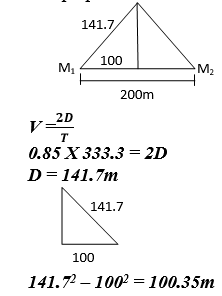
= 100.35m
- The velocity of sound in air. (1mk)
- A lawn sprinkler has 40 holes, each of cross-section area of 200cm. it is connected to a hose-pipe of cross section area of 1.6cm2. If the speed of water in the hose-pipe is 1.2m/s, calculate;
- Flow rate of hose-pipe. (2mks)
- Flow rate = A X V
= 0.00016 X 1.2
= 1.92 X 10-4 m3/s
- Flow rate = A X V
- Speed at which water emerges from the holes. (2mks)
- Volume efflux = V×2×10-2×10-4×40=8×10-5 m3/s
Volume influx = volume efflux
8×10-5 v=1.92×10-4
v=2.4m/s
- Volume efflux = V×2×10-2×10-4×40=8×10-5 m3/s
- Define the following terms as used in fluid flow.
- Volume flux. (2mks)
- Volume of fluid passing through a given section of a tube per unit time.
- Mass flux. (2mks)
- Mass of fluid that flows through a given section per unit time.
- Volume flux. (2mks)
- Flow rate of hose-pipe. (2mks)
- A water wave travels 12m in 4 seconds. If the frequency of the wave is 2Hz. Calculate;
- The speed of the wave. (2mks)
- Speed = dist/time
=12/4
= 3m/s
- Speed = dist/time
- The wavelength of the wave. (2mks)
- Speed = frequency X wavelength (v=fλ)
Therefore 3 = 2 X λ
Λ = 3/2
= 1.5m
- Speed = frequency X wavelength (v=fλ)
- The speed of the wave. (2mks)
Download Physics Questions and Answers - Form 2 End of Term 3 Exams 2022.
Tap Here to Download for 50/-
Get on WhatsApp for 50/-
Why download?
- ✔ To read offline at any time.
- ✔ To Print at your convenience
- ✔ Share Easily with Friends / Students

